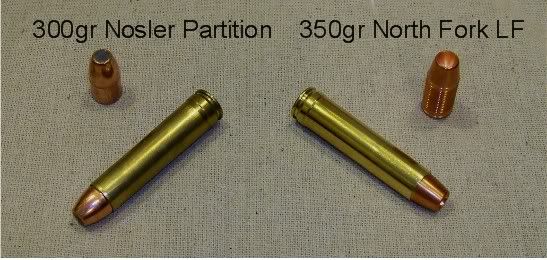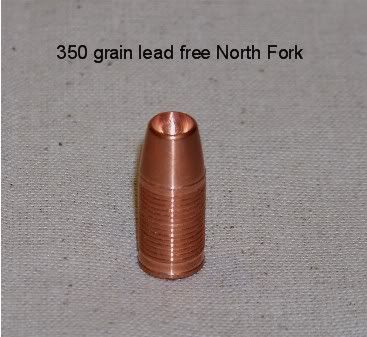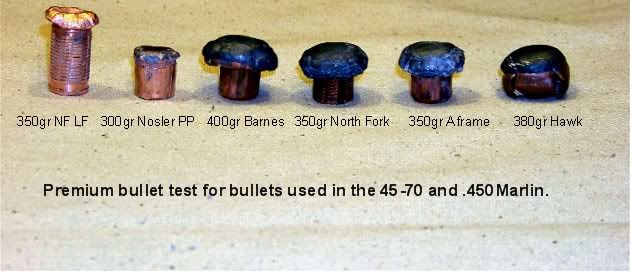


Hello boys and girls. I have been chomping at the bits to get back to shooting the ballistic buffalo. I finally got to go back and shoot the poor thing to death. Several things need to be understood before just looking at the chart and drawing conclusions. Please read the all of the commentary before drawing conclusions on score alone. I am still trying to create a totally fair scoring system that completely represents what actually happened to the buffalo on each shot. At best I can only get close. I hope you enjoy this. Reflex264
Media VS. Game
Before we go anywhere we need to understand how this test was done. When I refer to premium bullets I am referring to bullets that are generally designed to expand better, penetrate deeper or be more accurate than a standard off the shelf bullet. These bullets cost more because there is more work involved than with a simple cup and core design. To test them is tricky but I believe I have a handle on it. When shooting media that is supposed to simulate game you have to take into consideration that it isn’t breathing, isn’t going to try to kill you and you don’t have to have a kill tag. I started playing with medias years ago. I have been to the wet news print extreme and decided that all I was proving was that I didn’t like the stories in the papers so I shot them. I started playing with damp media and got more realistic results when compared to recovered bullets from big game animals.
I started using big steer bones that still had meat attached in a few places. The steer bones were a good test as long as you anchor them and can simulate the weight of an animal on its feet. Steer bone backed by damp magazines proved to be a good predictor of the outcome on animals. The steer bones had several draw backs though. The first one is that bacteria grows like wildfire on them. Naturally as soon as we pull them out and let them thaw they become a giant Petri dish. This was potentially dangerous. They are only available at certain times and I don’t want to store a ton of them. They stink. A lot.
The solution came when I discovered that I could duplicate the results using dry paper catalogs. Nearly all the tests come out so close that it makes me wonder why we ever used the bones. Using this method I correctly predicted the out come of bullet performance on elk, moose, bear, water buffalo and all manner of plains game. Using damp media vs. wet news print gives a much more realistic picture of how a bullet will react when it hits something that actually has tensile strength, not just weight and density. These tests are based on tests that I have done that proved to be accurate measuring tools when real game was encountered. To put these tests in perspective normal thin jacketed cup and core bullets will only score in the 200 range and the Barnes 250TSX and 300TSX only manage in the 300s even though we know they are great game killers. The 250gr TSX often only penetrated 4” or so at 2500fps.
The Nosler 300gr Protected Point
The 300 grain Nosler doesn’t need an introduction. It already has a fan club. It actually has the lowest score in the test at 509 but was the second best penetrating bullet in the test. This is the one bullet that numbers just don’t do justice. Why have numbers? The numbers do give a representation of damage done but in this bullet’s case the numbers leave off a very important factor. This bullet will break any bone in a buffalo and keep going. The very nature of its design begins with a bullet designed to expand easily but when it meets with media that exceeds the bullet’s petals tensile strength the petals will shear off and the core keeps going. In softer media the penetration difference between this bullet and the rest of the bullets tested is much greater. After the petals shear the core keeps on penetrating. This is one of the bullets that I sent out in test lots all over the country and had hunters from the US carry them to Canada. It was no surprise when nearly everyone that carried them told me it was the most devastating bear killer they had ever seen.
Velocity: 2100fps
Energy: 2938 foot pounds
Retained weight: 234 grains
Expanded diameter: .550”
Penetration: 13 5/8”
Displaced matter: at 7” penetration: 53.5
Overall score: 509
The 350 grain North Fork
This bullet doesn’t need an introduction either. The bullet uses a solid copper base with a lead core filling in the front of the bullet. It has grooves turned into the shank to keep pressures at bay. This was one of the most impressive bullets I have ever shot into the buffalo. It had the highest overall score and tied for matter displaced against the 380 grain Hawk with the .050” jacket. The wound channel was cavernous. At the front of the media was a dry paper book 1.75” thick. All of the bullets had to go through
one of these books before contacting the damp media. This bullet left a huge hole in the dry paper unlike most of the bullets which simply punched a hole in it then while already expanded it cut a huge cone shaped wound. Once the wound reached its largest surface area the bullet simply cut a short cylinder about 7/8” in diameter. A note of interest is I was able to get 2150fps out of the guide guns short barrel. That was the last one I shot and the case expansion numbers said I better quit right there. I would back it off for the next test. A realistic velocity for a hot weather load would be 2075fps. Even at around 1850fps this bullet simply cleans house.
Velocity: 2150fps
Muzzle energy: 3593ftlbs
Retained weight: 347 grains
Expanded diameter: .800”
Penetration: 11 ¼”
Displaced matter: @ 7” penetration 72.00
Overall score: 810
The 350 grain Swift A-Frame
This bullet has a partition dividing the front lead core from the rear lead core similar to the Nosler. There is a huge difference in the construction of this bullet compared to the Nosler however. The lead core is bonded to the jacket material. It works from a different school of thought. Not bad just different. Swift’s purpose is to maintain a large frontal area throughout penetration. It achieves this goal but every time I have tested them they appear to have a delayed expansion compared to other similar purpose bullets. Swift may intend this bullet for thick skinned game where it would be desirable for the bullet to open up with a slight delay to insure that the bullet remains intact during the initial contact with the animal. If this is their goal they have certainly achieved it. The wound was a reflection of this action from the bullet. It lacked the huge cavern in the stiff media that its peers achieved but it penetrated straight as a arrow and it did what I call out flow disturbance on par with the other bullets. I can see this bullet performing great on elk, moose or big bears but my personal feeling is that it is a bit to tough to expand well on deer sized game. As it has been said before: It’s already .458” in diameter so does it really need much expansion? Another note on loading this bullet that need to be addressed is the pressure. I went ahead and used the data from 2050fps. I fired two bullets with virtually identical performance at this velocity but the load needed to be backed off. I shot these alongside loads with known pressures and the CHE numbers told me to back off. The realistic velocity to shoot for with this bullet is 1975fps from a 18” .450 or 45-70 and 2010 from a 22” barrel.
Velocity: 2050fps
Muzzle energy: 3267ftlbs
Retained weight: 337 grains
Expanded diameter: .740”
Penetration: 11”
Displaced matter: @ 7” penetration 32.71
Overall score: 589
The North Fork 350 grain cup point
When Hal contacted me about this bullet I will admit I was a bit skeptical. I wasn’t sure about the hardness of the bullet but I figured the little cup on the front would have a hard time initiating expansion. I have been wrong before and once again I was wrong. The bullet appeared to be expanded as it exited the dry book in front of the damp media. The wound channel was more of a consistent tube than a cone. It was a bit strange that the wound started out nearly an inch larger at the media behind the dry book than it was at 7” but this is easily explained. The bullet didn’t gain as much frontal area during expansion as most of the bullets and it started out with less velocity than the others. The decrease in size of the wound was due to (1) the bullet quit expanding and started cutting and (2) deceleration without additional expansion. It pretty much made up for that however by penetrating 3 3/8” more than the penetration runner up. Loading this one was a bit of a challenge. My first instinct when working with new bullets is to start with H322. It is nearly impossible to get in trouble with pressures as long as common sense is used. This bullet was longer by a good bit than even the 400 grain Barnes so using any other 350 grain data is out. My initial shot netted 1535fps with a compressed load. I instantly knew to go back to the drawing board. After looking at my data there was one powder that looked promising; IMR4198. I began tinkering with the case capacity and measured the case and the bullet. I decided to try this bullet in the .450 Marlin. The .450 Marlin would probably be the smallest capacity case in which this bullet would be used. Since I had a limited number of bullets to work with I figured I would do it all at one time. We set the chronograph in front of the ballistic buffalo so we could measure velocity as we were testing for expansion and penetration. I actually did this with the 1535fps load first. The result was a good clean reading on the chrony and a nice hole in the buffalo. The bullet reached 1803fps. I compared the CHE number to a load I already had pressure data for and the CHE was exactly the same. Granted this is a sample of one but from past experience sending CHE worked up loads to the lab I feel pretty confident in the load being safe.
As far as my gut feeling on this one I believe I would take on a water buffalo or cape buffalo with it. It might also interest you that the load that only achieved 1535fps expanded just fine and got 13.00” penetration.
Load data for the 350 Grain cup point North Fork
Hornady .450 Case
CCI 200 primer
42.4 grains of IMR4198
Velocity: 1803fps
Muzzle energy: 2527ftlbs
Retained weight: 343.6 grains
Expanded diameter: .667’’
Penetration: 17.00”
Displaced matter: @ 7” penetration 39.46
Overall score: 670
The 380gr Hawk Custom with a .050” jacket
All of you old timers will remember my folly with this bullet. When I was working on loads for commercial use this was the bullet I wanted the world to see. I ended up beating my brains out trying to get a producible load because of pressure issues. I finally hit the nail on the head and got a load for the 45-70 that would run 1980fps at 38,000CUP. The load was accurate and would demolish everything I pointed it at. The problem was the .050” jacket. The thicker the jacket the greater the pressure. To achieve the toughness I wanted the super thick jacket was a necessity. This bullet expands quickly and hangs tough even on huge bones. Early testing with this bullet in Africa netted cape buffalo and a huge male lion. It did everything I hoped for. I got a request to do some work ups with the .450 Marlin and that is how I got started with that cartridge. To be honest I had already judged the cartridge before I ever saw one. While I was preparing a lot of cartridges to go to the lab it dawned on me that I needed to try the Hawk. As much trouble as I had in the 45-70 with this bullet it turned out to be right at home in the .450. With a higher pressure threshold to work with I had them running 2025fps from my .450 Guide Gun even with its short barrel. The load was a tack driver right off the bat. I sent this bullet along with loads using the 400gr Barnes original, the 300gr Nosler and the 250TSX Barnes. When they faxed back the pressure sheets there was a cover sheet that noted I had finally got it right with that bullet. It is a devastating bullet and can be ordered on a custom basis from Hawk. It isn’t cheap and you have to buy several of them at a time. It does have a high BC for a bullet of this type. While the displacement was identical to the leaded North Fork the total volume ( not the way I used my new scoring system) was by far the largest. I have decided at least for the present to use the first 7” behind the up-setter whether it be real bone or dry paper.
Velocity: 1980fps
Muzzle energy: 3309ftlbs
Retained weight: 318 grains
Expanded diameter: .889”
Penetration: 10 ¾”
Displaced matter: @ 7” penetration 72.00
Overall score: 774
The 400 grain Barnes Original
This bullet was made famous by John Wooters in several magazine articles from the 1970s. He used it on a safari in Africa. His rifle was a Ruger #1 in 45-70. He even amazed his guide by dropping a huge leopard with one well placed shot. This bullet is constructed like the Hawk but with a .030” jacket which is still pretty thick. It is a easy bullet to load for the .450 and 45-70. My lab results came back perfect the first time out with it. Each of the bullets in this test had some distinguishing performance that it did better than the rest. In the Barnes Original’s case it was the only bullet that would leave a wound sized tube all the way through the dry book. The diameter in the dry book would match the damp media diameter. This feature makes this bullet a great black bear bullet. It would be like getting hit by a truck. This bullet is one of the conundrum bullets that the .450 will shoot faster than the 45-70 with both loaded to their respective maximum pressures. For this test I chose to use my pet load with this bullet. It leaves the barrel of the .450 Guide Gun at 1748fps and is super accurate. Despite the fact that this bullet is not bonded and doesn’t have a partition or a solid copper shank it always does a great job in the ballistic buffalo. Consider that a 405gr Remington shot into this same exact set up breaks up by the time it has went 6’’ and you can start to appreciate what a big bullet with a thick jacket can do.
Velocity: 1748fps
Muzzle energy: 2715ftlbs
Retained weight: 236 grains
Expanded diameter: .859”
Penetration: 11”
Displaced matter: @ 7” penetration 72.00
Overall score: 690
